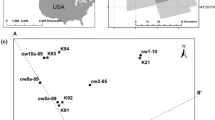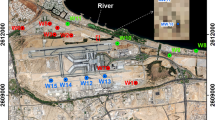Abstract
A method to estimate aquifer thickness and hydraulic conductivity has been developed, consisting of multiple pumping tests. The method requires short-duration pumping cycles on an unconfined aquifer with significant seasonal water-table fluctuations. The interpretation of several pumping tests at a site in India under various initial conditions provides information on the change in hydrodynamic parameters in relation to the initial water-table level. The transmissivity linearly decreases compared with the initial water level, suggesting a homogeneous distribution of hydraulic conductivity with depth. The hydraulic conductivity is estimated from the slope of this linear relationship. The extrapolation of the relationship between transmissivity and water level provides an estimate of the aquifer thickness that is in good agreement with geophysical investigations. The hydraulically active part of the aquifer is located in both the shallow weathered and the underlying densely fractured zones of the crystalline basement. However, no significant relationship is found between the aquifer storage coefficient and initial water level. This new method contributes to filling the methodological gap between single pumping tests and hydraulic tomography, in providing information on the variation of the global transmissivity according to depth. It can be applied to any unconfined aquifer experiencing large seasonal water-table fluctuations and short pumping cycles.
Résumé
On a développé une méthode pour estimer l’épaisseur et la conductivité hydraulique d’un aquifère, consistant en pompages d’essai multiples. La méthode requiert des cycles de pompage de courte durée sur un aquifère libre présentant des fluctuations piézométriques saisonnières significatives. L’interprétation de plusieurs pompages d’essai réalisés sur un site en Inde sous différentes conditions initiales fournit une information sur la variation des paramètres hydrodynamiques en fonction du niveau piézométrique initial. La transmissivité décroît linéairement avec le niveau piézométrique initial, suggérant une distribution homogène de la conductivité hydraulique avec la profondeur. La conductivité hydraulique est déduite de la pente de cette relation linéaire. L’extrapolation de la relation entre transmissivité et niveau piézométrique fournit une estimation de l’épaisseur de l’aquifère en bonne concordance avec les investigations géophysiques. La partie hydrauliquement active de l’aquifère est localisée dans la zone altérée superficielle et dans la partie densément fracturée du socle cristallin. Cependant, aucune relation significative n’est trouvée entre le coefficient d’emmagasinement de l’aquifère et le niveau piézométrique initial. Cette nouvelle méthode contribue à combler la lacune méthodologique existant entre le simple pompage d’essai et la tomographie hydraulique, en fournissant une information sur la variation de la transmissivité globale selon la profondeur. Elle peut être appliquée à n’importe quel aquifère libre présentant d’importantes fluctuations piézométriques saisonnières et des cycles de pompage courts.
Resumen
Se ha desarrollado un método para estimar la conductividad hidráulica y espesor de un acuífero, que consiste en ensayos de bombeo múltiples. El método requiere ciclos de bombeo de corta duración en un acuífero no confinado con significativas oscilaciones estacionales de los niveles freáticos. La interpretación de los ensayos de bombeo múltiples en un sitio en India bajo varias condiciones iniciales provee información sobre el cambio en los parámetros hidrodinámicos en relación al nivel freático inicial. La transmisividad decrece linealmente comparada con el nivel freático inicial, lo que sugiere una distribución homogénea de la conductividad hidráulica con la profundidad. La conductividad hidráulica se estima a partir de la pendiente de esta relación lineal. La extrapolación de la relación entre transmisividad y el nivel del agua provee una estimación del espesor del acuífero que está en un buen acuerdo con las investigaciones geofísicas. La parte activa hidráulicamente del acuífero está localizada tanto en las zonas someras meteorizadas como en las zonas subyacentes densamente fracturadas del basamento cristalino. Sin embargo, no se encontró ninguna relación significativa entre el coeficiente de almacenamiento del acuífero y el valor inicial del nivel de agua. Este nuevo método contribuye a llenar una brecha metodológica entre los ensayos de bombeo simples y la tomografía hidráulica al proveer la información sobre la variación global de la transmisividad global en función de la profundidad. Se puede aplicar a cualquier acuífero no confinado que experimenta grandes fluctuaciones estacionales del nivel freático y cortos ciclos de bombeo
摘要
本文提出一种根据多个抽水试验估算含水层厚度和水力传导率的方法。此方法要求地下水位有季节波动的非承压含水层有短时间的抽水循环。印度某地区不同初始条件下的几个抽水试验结果为与初始水位有关的水动力参数的变化提供了信息。同初始水位相比, 导水率线性减小, 表明随深度变化, 水力传导率呈均一分布。水力传导率是通过此线性关系的斜率估算的。导水率和地下水位的关系曲线的外延给出了含水层厚度的估算值, 该值与地球物理勘探结果一致。含水层水力梯度较大的地区位于浅部风化区和下伏结晶岩基底的断裂密集带区。但是, 并没有发现含水层储存系数和初始水位之间存在相关性。在提供与深度有关的综合导水率变化的信息方面, 此方法填补了单个抽水试验和水力层析法之间的空白, 可应用于地下水位有大的季节变化和短期的抽水循环的任意非承压含水层。
Resumo
Desenvolveu-se um método baseado em ensaios de bombagem múltiplos para estimar a espessura do aquífero e a sua condutividade hidráulica. O método requer ciclos de bombagem de pequena duração num aquífero livre com flutuações de nível freático sazonais significativas. A interpretação de vários ensaios de bombagem num local da Índia, sob diferentes condições iniciais, dá informação sobre a mudança dos parâmetros hidrodinâmicos em relação ao nível freático inicial. A transmissividade decresce linearmente em comparação com o nível freático inicial, indiciando uma distribuição homogénea da condutividade hidráulica com a profundidade. A condutividade hidráulica estima-se a partir do declive desta relação linear. A extrapolação da relação entre a transmissividade e o nível freático dá uma estimativa da espessura do aquífero, a qual tem uma boa concordância com a investigação geofísica. A parte hidraulicamente activa do aquífero localiza-se quer na parte subsuperficial alterada, quer nas zonas densamente fracturadas do soco cristalino subjacente. Contudo, não se encontrou uma relação significativa entre o coeficiente de armazenamento do aquífero e o nível freático inicial. Este novo método contribui para preencher a lacuna metodológica entre ensaios de bombagem simples e tomografia hidráulica, ao fornecer informação sobre a variação da transmissividade global de acordo com a profundidade. Pode ser aplicado a qualquer aquífero livre que tenha grandes flutuações sazonais do nível freático e ciclos de bombagem curtos.











Similar content being viewed by others
References
Bangoy LM, Drogue C (1994) Analysis of intermittent pumping tests in fissured fractal aquifers: theory and applications. J Hydrol 158(1–2):47–59
Birsoy YK, Summers WK (1980) Determination of aquifer parameters from step tests and intermittent pumping data. Ground Water 18(2):137–146
Boulton NS (1970) Analysis of data from pumping tests in unconfined anisotropic aquifers. J Hydrol 10:369–378
Boulton NS, Pontin JMA (1971) An extended theory of delayed yield from storage applied to pumping tests in unconfined anisotropic aquifers. J Hydrol 14:53–65
Bourdet D, Ayoub JA, Pirard YM (1989) Use of pressure derivative in well-test interpretation. SPE Form Eval 4(2):293–302
Braun JJ, Descloitres M, Riotte J, Fleury S, Barbiero L, Boeglin JL, Violette A, Lacarce E, Ruiz L, Sekhar M, Kumar MSM, Subramanian S, Dupree B (2009) Regolith mass balance inferred from combined mineralogical, geochemical and geophysical studies: mule hole gneissic watershed, south India. Geochim Cosmochim Acta 73(4):935–961
Butler JJ Jr, McElwee CD, Bohling GC (1999) Pumping tests in networks of multilevel sampling wells: motivation and method. Water Resour Res 35(11):3553–3560
Chapellier D (1987) Diagraphies appliquées à l’hydrologie [Wells logging applied to hydrology]. Lavoisier, Paris
Chilton PJ, Foster SSD (1995) Hydrogeological characteristics and water-supply potential of basement aquifers in tropical Africa. Hydrogeol J 3(1):3–49
Chow VT (1952) On the determination of transmissibility and storage coefficients from pumping test data. Trans Am Geophys Union 33:397–404
Davis SN, Turk LJ (1964) Optimum depth of wells in crystalline rocks. Groundwater 2(2):6–11
Descloitres M, Ruiz L, Sekhar M, Legchenko A, Braun JJ, Mohan Kumar MS, Subramanian S (2008) Characterization of seasonal local recharge using electrical resistivity tomography and magnetic resonance sounding. Hydrol Process 22(3):384–394
Dewandel B, Lachassagne P, Wyns R, Marechal JC, Krishnamurthy NS (2006) A generalized 3-D geological and hydrogeological conceptual model of granite aquifers controlled by single or multiphase weathering. J Hydrol 330(1–2):260–284
Gottlieb J, Dietrich P (1995) Identification of the permeability distribution in soil by hydraulic tomography. Inverse Probl 11:353–360
Houston JFT, Lewis RT (1988) The Victoria province drought relief project, II: borehole yield relationships. Ground Water 26(4):418–426
Howard KWF, Hughes M, Charlesworth DL, Ngobi G (1992) Hydrogeologic evaluation of fracture permeability in crystalline basement aquifers of Uganda. Hydrogeol J 1(1):55–65
Kruseman GP, Ridder NA (1990) Analysis and evaluation of pumping test data. ILRI, Nairobe, Kenya, 377 pp
Maréchal JC (2009) Editor’s message: the sunk cost fallacy of deep drilling. Hydrogeol J 18:287–289. doi:10.1007/s10040-009-0515-2
Maréchal JC, Dewandel B, and Subrahmanyam K (2004) Use of hydraulic tests at different scales to characterize fracture network properties in the weathered-fractured layer of a hard rock aquifer. Water Resour Res 40(11):W11508
Maréchal JC, Dewandel B, Galeazzi L, Bournet G, Ahmed S (2006) Combined estimation of specific yield and natural recharge in a semi-arid groundwater basin with irrigated agriculture. J Hydrol 329(1–2):281–293
Massuel S, Perrin J, Wajid M, Mascre C, Dewandel B (2009) A simple, low-cost method to monitor duration of ground water pumping. Ground Water 47(1):141–145
Mayo AL, Morris TH, Peltier S, Petersen EC, Payne K, Holman LS, Tingey D, Fogel T, Black BJ, Gibbs TD (2003) Active and inactive groundwater flow systems: evidence from a stratified, mountainous terrain. GSA Bull 115(12):1456–1472
Moyen JF, Martin H, Jayananda M (2001) Multi- element geochemical modeling of crust–mantle interactions during late-Archean crustal growth: the Closepet granite (South India). Precambrian Res 112:87–105
Neuman SP (1975) Analysis of pumping test data from anisotropic unconfined aquifers considering delayed gravity response. Water Resour Res 11(2):329–342
Paillet FL (1998) Flow modeling and permeability estimation using borehole flow logs in heterogeneous fractured formations. Water Resour Res 34(5):997–1010
Taylor R, Howard K (2000) A tectono-geomorphic model of the hydrogeology of deeply weathered crystalline rock: evidence from Uganda. Hydrogeol J 8(3):279–294
Theis CV (1935) The relationship between the lowering of the piezometric surface and the rate and duration of discharge of a well using groundwater storage. Eos Trans AGU 16:519
Acknowledgements
The Maddur Basin study is part of the ORE-BVET project (Observatoire de Recherche en Environnement – Bassin Versant Expérimentaux Tropicaux). Apart from specific support from the French Institute of Research for Development (IRD), the Embassy of France in India and the Indian Institute of Science, our project benefited from funding from IRD and INSU/CNRS (Institut National des Sciences de l’Univers/Centre National de la Recherche Scientifique) through the French programmes ECCO-PNRH (Ecosphère Continentale: Processus et Modélisation – Programme National Recherche Hydrologique) and EC2CO (Ecosphère Continentale et Côtière). It was also funded by IFCPAR (Indo-French Center for the Promotion of Advanced Research W-3000) and supported by ANR (National Research Agency, France) under VMCS Programme No. ANR-08-VULN-010-03/SHIVA. The multidisciplinary research carried out on the Maddur watershed began in 2005 under the control of the IISc/IRD laboratory IFCWS (Indo-French Cell for Water Sciences). The authors kindly thank M. Sekhar, S. Subramanian and J.J. Braun for their support. The contributions of Associate Editor Nadim Copty and Thomas Graf were highly appreciated.
Author information
Authors and Affiliations
Corresponding author
Rights and permissions
About this article
Cite this article
Maréchal, JC., Vouillamoz, JM., Mohan Kumar, M.S. et al. Estimating aquifer thickness using multiple pumping tests. Hydrogeol J 18, 1787–1796 (2010). https://doi.org/10.1007/s10040-010-0664-3
Received:
Accepted:
Published:
Issue Date:
DOI: https://doi.org/10.1007/s10040-010-0664-3




